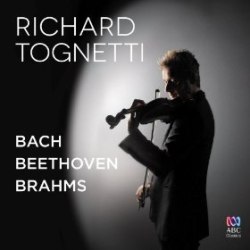| 
Support
us financially by purchasing this disc from |
 |
 |
|
Johann Sebastian BACH (1685-1750)
Sonata for Violin and Keyboard No. 2 in A major, BWV1015 (Dolce I) (1720) [3:50]
Ludwig van BEETHOVEN (1770-1827)
Violin Concerto in D major, Op. 61 (Allegro ma non troppo I) (1806) [23:23]
J. S. BACH (1685-1750)
Sonata for Violin and Keyboard No. 2 in A major, BWV1015 (Andante un poco III) (1720) [3:42]
Johannes BRAHMS (1833-1897)
Symphony No. 1 in C minor, Op. 68 (Un poco sostenuto - Allegro I) (1876) [15:34]
J. S. BACH (1685-1750)
Violin Concerto in A minor, BWV1041 (1717-23) [13:15]
Richard Tognetti (violin)
Australian Chamber Orchestra (Beethoven and Brahms), Neal Peres Da Costa (chamber organ, sonatas), and Daniel Yeadon (viola da gamba, sonatas)
rec. 24 May 2005, 12 July 2006 (sonatas); 2007 (Beethoven and Brahms); 21 Oct 2005 (concerto), Australia.
ABC CLASSICS 481 0679 [64:17]
Only one work here is complete. The rest are extracts.
After Bach’s sweet and songlike Dolce from BWV1015, which is soothing and restful, the listener lurches forward (both in time and most probably in his seat) upon hearing the opening throes of Beethoven’s Violin Concerto. To quote Edmond de Goncourt, this astonishing piece begs us to ask, if ‘A poet is a man who puts up a ladder to a star and climbs it while playing a violin’ what on earth is Beethoven? Yognetti plays the Giuseppe Guarneri del Gesu, Cremona, 1743 ‘Carrodus’ violin. This was supposedly once played by Paganini who sold it to cover his gambling losses. Tognetti unveils multifarious textures and supple strength to embody the complex and oftentimes conflicting character of the Beethoven. Speaking about the qualities of this violin in an interview for Strings in 2011, Tognetti describes it as: ‘A very elusive character […] It’s a weeping, dancing, singing instrument I’m still exploring, and that’s what makes it so demanding.’ In this performance the listener gets a sense of Tognetti’s exploratory adventure. Using gut strings and with the ‘depth, beauty and mystery’ of this instrument both a uniquely temperate and tempestuous character emerges: perfectly suited to the Beethoven. When asked ‘What would your instrument say to you if the two of you sat down for tea’, Tognetti replies: ‘Stop slurping, Richard’. This light-hearted retort is not only a good humoured quip, but reveals the technical precision and clear sense of intention required to play such a demanding instrument. Tognetti’s is a convincing performance and retains the dialogue between tension and relief, delivering each note with exacting intonation. Demonstrating crisp technique, Tognetti presents Beethoven’s extremes of vigour and elegance; the same also found in the Eroica Symphony and the Appassionata, all composed during his, so called, ‘Heroic period’. Keeping the bow close to the strings, Tognetti shapes each note purposefully and with, for lack of a better word, grit.
Continuing with the third movement of from BWV1015 Tognetti demonstrates how the violin can morph, droop and wilt, then well-up with downcast tones. In the Adagio of Bach’s Sonata for Violin and Keyboard No. 6 in G major,consolingtenderness is exchanged between the chamber organ and viola da gamba. These are played sensitively by Neal Peres Da Costa and Daniel Yeadon, respectively. The quietude and stillness of the slow movements of these Sonatas allows Tognetti to illustrate his intimacy and softer, yet still focused delivery.
Brahms’ Symphony No. 1 opens in a grave and forlorn manner. Growing out of this feeling of dejection, Tognetti confronts the delicacy and intellectual scope of the piece directly. With the low beat of the kettledrum, falling woodwind figure and rising strings (covering a three-octave range), alongside a pizzicato segment, burgeoning phrases and a melody on the oboe; this piece opens with a broad scope from which numerous directions can be taken. In 1877, conductor Hans von Bulow was so moved by it that he called the symphony ‘Beethoven’s Tenth’, referring to the uncanny similarities in Brahms’s overarching intention and fate motif to those of Beethoven. Perturbed by being branded as a Beethoven ‘wannabe’ and most likely fully aware of his indebtedness to the former composer; when confronted with comments alluding to his ‘borrowings’ from and imitation of Beethoven, Brahms snapped: ‘any ass can see that’. With a similar one-two punch (and an excellent wind-section), the Australian Chamber Orchestra gives a confident and assertive performance.
Finishing with Bach’s Violin Concerto in A minor, Tognetti performs with sheer virtuosity. The piece seems to buzz and come alive. His ornamentation and phrasing is pithy and not at all over-sentimentalised. Throughout this CD, Tognetti’s tone is astonishingly piercing as it shines through each piece with a pallor which is yet never wan or insipid. Whilst each note is played in a concentrated, thoughtful way, nothing sounds overworked as Tognetti blends his intrusive focus with technical ease and facility. The sound quality of this ABC Classics recording carries the textures - both gentle and edgy - leaving the sound alive, still buzzing in the mind.
Lucy Jeffery
Previous review (Bach concerto): Jonathan Woolf
Masterwork Index: Bach violin concerto 1
 |
 |
|
